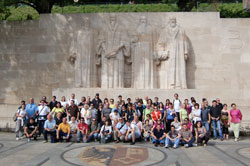Geneva 2009: a journey through historical places aiming to the future
This year is the fifth centenary of Calvin’s birth and, with this important anniversary in mind, CERBI has organised a tour of the places where Calvin lived and committed himself to Reformation. The tour took place last weekend, and a hundred people belonging to CERBI churches and other evangelical Italian churches took part in it.
The expectations raised were of varied nature: getting to see the places where Reformation spread; getting in touch with what one has studied on Reformation and Calvin in order to root down previous knowledge; being able to share inter-ecclesial unity and diversity; getting to visit a cultural forge such as Geneva and understand its cultural debt to Reformation; coming to see where Calvin has spent most of his life and learn more of the man who set an indelible trace in the history of Reformation.
The schedule started off with Friday afternoon’s journey from Italy.
 |
|
The next morning the group went to the old city centre of Geneva and visited the sites of historical significance for Reformation: Saint Peter’s Cathedral, where Calvin preached; the street in which the latter lived; the calvinian boarding-school, the auditorium of the calvinian academy; and finally the Museum of Reformation. In the afternoon the group participated to a conference on “The Evangelical Witness in Romand Switzerland since Calvin: challenges and opportunities”, arranged by CERBI and the Romand Evangelical Alliance, represented by Jacques Blandenier and Jean-Paul Zurcher.
Then a due visit to the “Wall of Reformation” followed.
This is the first genevois monument dedicated to Reformation and it is most meaningfully placed on the fortifications that protected the old city. In this stone sculpture Calvin, Guillaume Farel, Théodore de Béze and John Knox are represented along with other six reformers and political figures of Calvinistic legacy in foreign countries such as Gaspard de Coligny, Guillaume le Taciturne, Fréderic Guillaume of Brandenburg, Roger Williams, Oliver Cromwell, Etienne Bockskay.
On two big lateral slabs framing the wall are the engraved names of Luther and Zwingli.
The day ended with the sharp analysis of prof. Bolognesi on the five causes that prevented the development of Reformation in Italy in 16th century.
First obstacle: the Spanish political power structure, overtly confessional (catholic), which hindered any establishment of other religious confessions.
Second obstacle: the unwillingness of Italian aristocracy of giving up its own private and particular concerns, and the tendency of considering any religious experience as destabilising, especially of the Calvinistic kind.
Third obstacle: the “out-of-phase” condition of Italian culture compared to that of other European countries. Since humanism established itself before Reformation, the thrust to find further spiritual freedom and renewal had already subsided and therefore the urge for a systematic reformation of knowledge was lacking.
Fourth obstacle: the open hostility of Roman Catholic Counter-reformation. With its organic and systematic reaction, strangling and persecuting those approaching reformed ideas, Inquisition was hard to oppose or even to flee from.
Fifth obstacle: the typical Italian mistrust towards the attainment of an organic and comprehensive doctrinal system.
This attitude focuses more on doctrinal particularism rather than achieving a global vision, therefore resulting in a lack of solidarity and temperament. Mutatis mutandis, these obstacles still have clout today.
The final impressions of this trip are very positive, and expectations were fulfilled. Visiting the sites of Reformation was thought provoking in terms of individual and ecclesial perspectives for the future. The historical legacy of Calvin and of the other Reformers may survive only if experienced and contextualised; if not, it can only burn out. Nowadays Geneva is an unquestionable proof of this. Back in 1536 the city accepted the Reformation, today the evangelicals (the heirs of Reformation), sum up just below of a 3%, the Catholic church and mainstream protestant churches being the major protagonists.
The growth rate of the Swiss evangelical church has been for the last twenty years equal to zero, whereas the mainstream protestant churches below zero.
These figures should be a strong warning to those who feel part of this heritage, because they underline the need of a prompte et sincere commitment to make this legacy grow and be a blessing for future generations as well as a reason to worship God. It is up to the heirs to sow persistently, while the Lord will raise and grow.